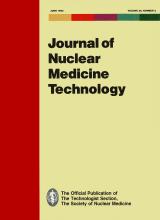Abstract
The clinical efficacy of a brain-dedicated single-photon emission tomography (SPECT) system, (GE/CGR Neurocam, GE/CGR, Buc, France) was assessed in normals and in a variety of brain disorders. Its three Anger-type gamma camera heads form a triangular aperture and offer a substantial increase in sensitivity compared to a single rotating camera. This has allowed the routine use of high resolution collimators for technetium-99m hexamethyl propylene amine oxime brain SPECT studies. The resulting improvement in spatial resolution, coupled with ease of patient positioning and greater patient throughput (compared to a conventional tomographic gamma camera) will enhance the role of brain SPECT for both routine and research purposes. The Neurocam is also suitable for dynamic SPECT studies with iodine-123 iodobenzamide.







